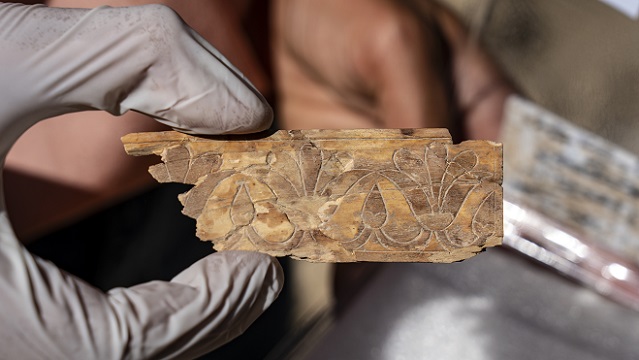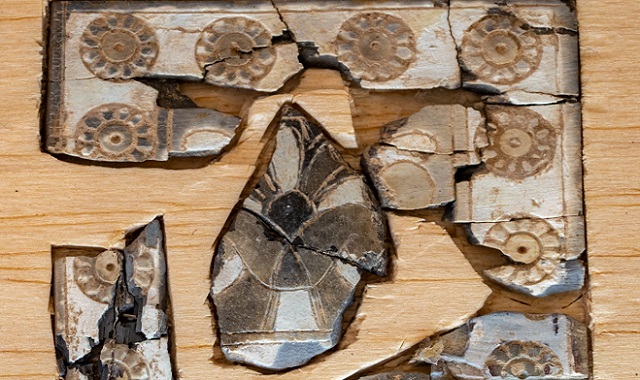
Reli Avisar from Tel Aviv University with an ivory plaque adorned with a lotus flower. (Photo: Yaniv Berman, Israel Antiquities Authority)
In yet another significant archeological find, an extraordinary discovery was unearthed in Jerusalem: an assemblage of ivory plaques from the First Temple period, among the few found anywhere in the world, and the first of their kind to be found in Jerusalem. It seems that there are frequent finds from this period of time, many of which have been found to confirm historical accounts recounted in the Bible.
The ivory plaques were uncovered during excavations being conducted by the Israel Antiquities Authority (IAA) and Tel Aviv University at the Givati Parking Lot in the City of David in the Jerusalem Walls National Park; the excavations are funded by the City of David Foundation. The archeological site is located just to the south of the Old City Walls opposite the gate that leads into the Western Wall compound. The area is called the City of David because it is the location of the original City of Jerusalem at the time of King David, in a little valley to the east of Mt. Zion.
The news comes less than a month after the IAA revealed that it had new insights into the power of the Roman army and the locations of their attack on Jerusalem during the battle that led to the destruction of the city and Second Temple in 70 A.D.
Will you offer us a hand? Every gift, regardless of size, fuels our future.
Your critical contribution enables us to maintain our independence from shareholders or wealthy owners, allowing us to keep up reporting without bias. It means we can continue to make Jewish Business News available to everyone.
You can support us for as little as $1 via PayPal at office@jewishbusinessnews.com.
Thank you.
Archaeological evidence was uncovered revealing the location of the Roman ballista firing machines and the intensity of the assault in the battles that led to the destruction of the Second Temple. Specifically, remnants of Roman weapons and such were found in what is now known as the Russian Compound – an area where a Russian Orthodox Church from the 19th Century stands – and a popular nightspot in downtown Jerusalem known as Cats Square.
Also in August, IAA made a rare archeological discovery. A rare assemblage of “astragali”—animal knuckle bones used for gaming and divination (seeking knowledge of the future or the unknown by supernatural means) —dating from the Hellenistic period (2300 years ago), was uncovered by Dr. Ian Stern in the Maresha-Bet Guvrin National Park in southern Israel.
As for the ivories, IAA explained that they were considered one of the costliest raw materials in the ancient world – even more than gold. They were found among the ruins of a palatial building in use when Jerusalem was at the height of its power (the eighth and seventh centuries BCE). Scholars believe that the decorated ivories were inlaid in wooden furnishings that were used by the residents of the building – people of means, influence and power, possibly high government officials or priests. The ivories will be on display next Tuesday, September 13th, at the 23rd Conference of the City of David Studies of Ancient Jerusalem. They will also be displayed in October at the Jerusalem Conference of the Israel Antiquities Authority, Tel Aviv University and the Hebrew University.
According to the excavation directors, Prof. Yuval Gadot of Tel Aviv University’s Department of Archaeology and Near Eastern Cultures and Dr. Yiftah Shalev of the Israel Antiquities Authority, “To date, we only knew of decorated ivories from the capitals of the great kingdoms in the First Temple period, such as Nimrud, the capital of Assyria, or Samaria, the capitol of the Israelite Kingdom. Now, for the first time, Jerusalem joins these capitals. We were already aware of Jerusalem’s importance and centrality in the region in the First Temple period, but the new finds illustrate how important it was and places it in the same league as the capitals of Assyria and Israel. The discovery of the ivories is a step forward in understanding the political and economic status of the city as part of global administration and economy.”
Ivory is mentioned only a few times in the Bible, always in connection with royalty or great wealth – the description of the throne of King Solomon (I Kings 10:18); an ivory palace built by King Ahab in Samaria (1 Kings 22:39); and the prophet Amos’ castigation of Israelite nobility: “They lie on ivory beds, lolling on their couches” (Amos 6:4).
The impressive building in which the ivories were unearthed was devastated in a huge fire, apparently during the Babylonian destruction of Jerusalem in 586 BCE, and the ivories were discovered smashed into tiny pieces and burnt. During the excavation, as part of the wet-sieving project in Emek Tsurim National Park, no fewer than 1,500 fragments were found. It was only after a unique restoration project, led by conservator Orna Cohen, and together with Ilan Naor from the Israel Antiquities Authority, that the plaques were restored, and the richness of the assemblage was revealed. “At the end of the process of joining and ‘fusing’ hundreds of the fragments, we were able to understand that the assemblage includes remnants of at least 12 small square plaques – about 5 cm x 5 cm, at most 0.5 cm thick – which were originally inlaid in wooden furnishings,” Cohen and Naor said.
The ivories that were discovered were not the only prestigious items found at the site. A seal made of agate (a semi-precious stone) was also unearthed, as well as a seal impression carrying the name “Natan-Melech servant of the king”, jars that had held vanilla-spiced wine, decorated stone items and wooden objects that were apparently part of other large wooden furnishings.
Decorated ivories are the rarest and most outstanding finds in archaeological assemblages. Their prestige stems from the source of the ivory: microscopic testing by Harel Shohat of the University of Haifa revealed that they were made from elephant tusk.
The decorations on most of the ivories were the same, consisting of frames incised with rosettes in the center of which was a stylized tree. Other plaques were adorned with lotus flowers and a geometric pattern. According to Dr. Ido Koch and Reli Avisar of Tel Aviv University, who studied the objects, the rosette and the tree were popular symbols in the Mesopotamian visual repertoire and in other cultural centers. Ivory objects with similar decorations were discovered in the assemblage of ivories from Samaria, and in more distant palaces, such as Nimrud and Khorsabad in the heart of the Assyrian Empire. The Judahite elite adopted these symbols during the time that Judah was under the rule of the Assyrian Empire (beginning in the second half of the eighth century BCE).
Interestingly, said the archeologists, these three symbols appeared at that time in Judah as symbols of the kingdom both on stone items that adorned opulent buildings (decorated stone capitals discovered in Jerusalem at Armon HaNatziv, at Ramat Rachel and Nahal Rephaim, as well as seals used in the royal administration (rosette seals were used to stamp jars, marking their contents as belonging to the royal household). Even more interesting is the fact that the animal and human mythological figures that appear on ivory items discovered in Samaria, Nimrud and other centers do not exist in the Jerusalem assemblage. “It’s possible that what we have here is evidence of a cultural choice by the Jerusalem elite as to which global symbols to adopt and which to reject,” the scholars say.





